Key takeaways:
- Active listening is crucial in conflict resolution, allowing individuals to feel heard and fostering understanding.
- Finding common ground among differing beliefs can help ease tensions and build a sense of community.
- Personal stories in pro-life advocacy can inspire compassion and strengthen commitment to the cause.
- Establishing a safe space and setting ground rules during mediation encourages open dialogue and reduces conflict.
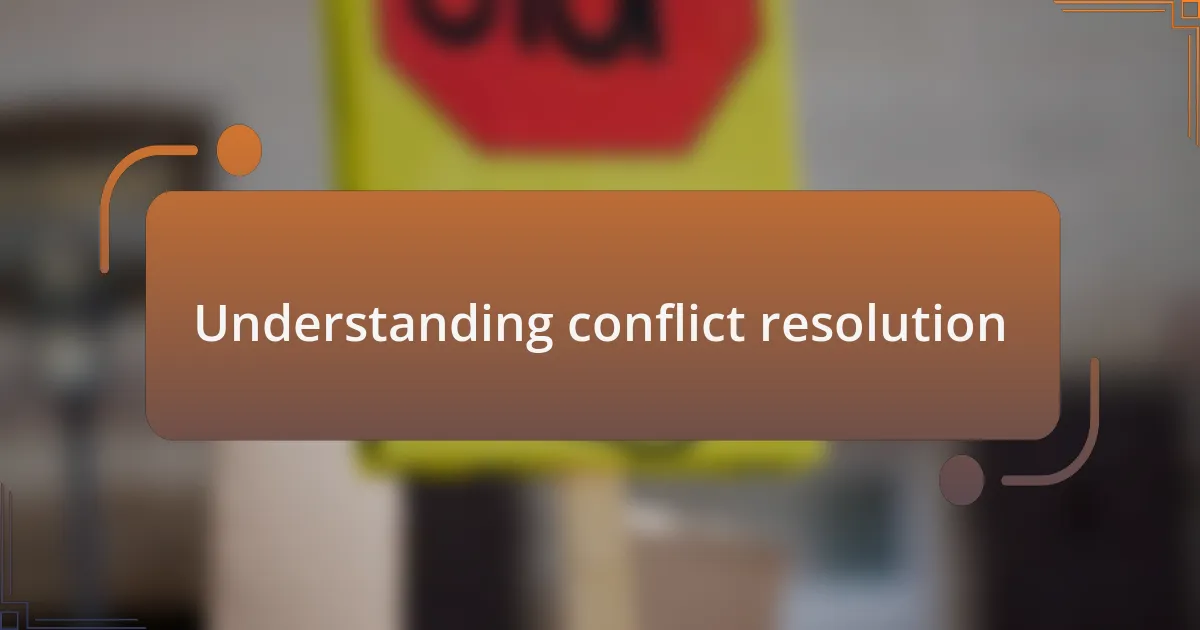
Understanding conflict resolution
Conflict resolution is a nuanced process that requires patience and empathy. I recall a situation in my community where differing opinions on a key issue nearly tore us apart. As I sat in a meeting filled with tension, I wondered: How can we transform our disagreements into opportunities for understanding?
One critical aspect of conflict resolution is active listening. I remember the breakthrough that happened when I simply paused to hear everyone’s concerns during a heated discussion. It was eye-opening to realize that by just being present, I gave others the space to express their feelings, which in turn allowed us to build a bridge over our differences.
Another vital element is finding common ground. In one instance, despite our varied beliefs, we all shared a passion for our community’s well-being. I reflected on this and realized that focusing on our shared goals helped to soften the contention, reminding us that our ultimate aim was to uplift one another, regardless of individual viewpoints.
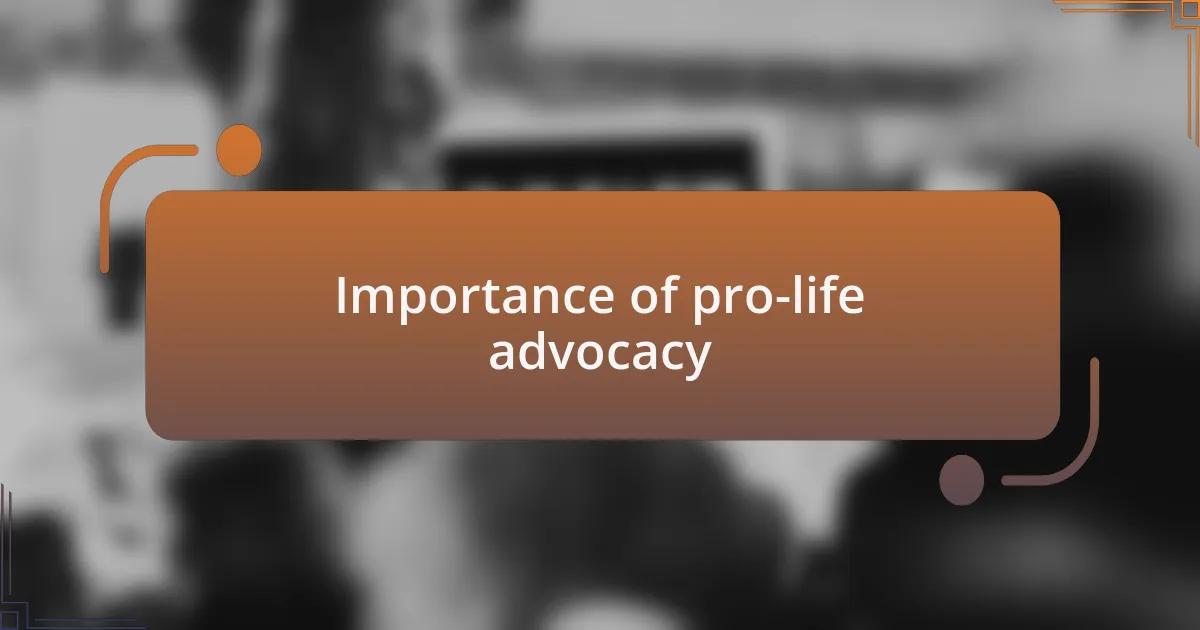
Importance of pro-life advocacy
Advocating for pro-life issues is crucial as it fosters a culture that values all human life, especially the most vulnerable among us. In my experience, I’ve seen how this advocacy leads to critical discussions on the sanctity of life, prompting individuals in my community to rethink their perspectives. It’s remarkable how these conversations can lead people to question their assumptions and explore their beliefs on a deeper level.
One moment that stands out to me was during a community forum where we discussed the implications of life-affirming policies. I was moved by a heartfelt testimony from a young mother who shared her story of choosing life against the odds. Hearing her courage not only inspired me but also galvanized others to stand firm in their commitment to pro-life advocacy. It’s these personal stories that awaken compassion in hearts and minds, sparking a collective desire to protect life.
Moreover, the importance of pro-life advocacy extends beyond individual stories; it helps forge a supportive community. I often think about how when we rally together for this cause, we’re not just advocating for policies—we’re building a network of support that encapsulates hope and solidarity. Wouldn’t it be wonderful if every community nurtured this ethos, reinforcing the belief that every life is worth living?
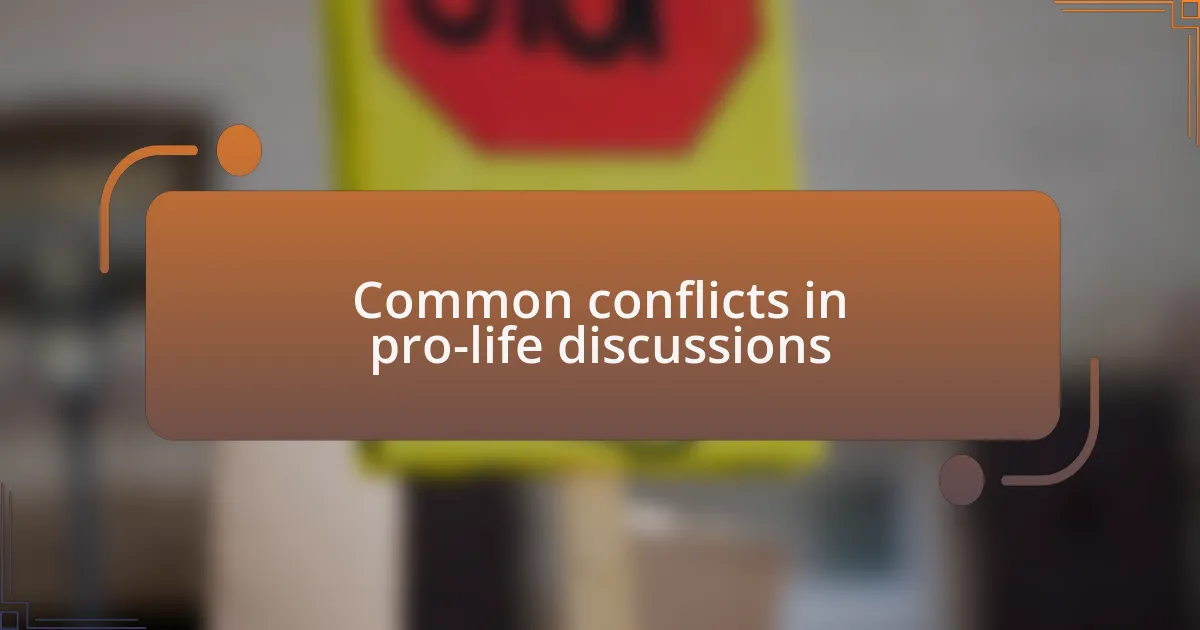
Common conflicts in pro-life discussions
Discussions surrounding pro-life issues can often ignite passionate disagreements among community members. One common conflict arises from differing beliefs about when life begins. For me, this has led to heated debates where emotions can run high. I remember a heated conversation at a local gathering, where one participant’s personal views clashed with another’s deeply rooted beliefs. It’s moments like these that highlight just how vital it is to approach these discussions with sensitivity and an open heart.
Another prevalent conflict centers around the role of government in reproductive rights. In my experience, some argue that legislative actions should protect the unborn, while others believe such decisions should remain in the hands of individuals. I participated in a discussion panel where this issue was front and center. I felt the tension in the room as people shared their convictions, and it prompted me to reflect on how critical it is to listen to each perspective, even when I didn’t agree.
Lastly, misconceptions about the pro-life movement itself often create divisions. Many perceive pro-life advocates solely as activists against abortion, missing the breadth of support offered to mothers, families, and children. During a community outreach event, I encountered individuals who were surprised to hear about the resources available for expectant parents. It made me wonder how miscommunication could hinder the shared goal of valuing every life. By embracing open dialogue, we can bridge these gaps and foster a more unified community.
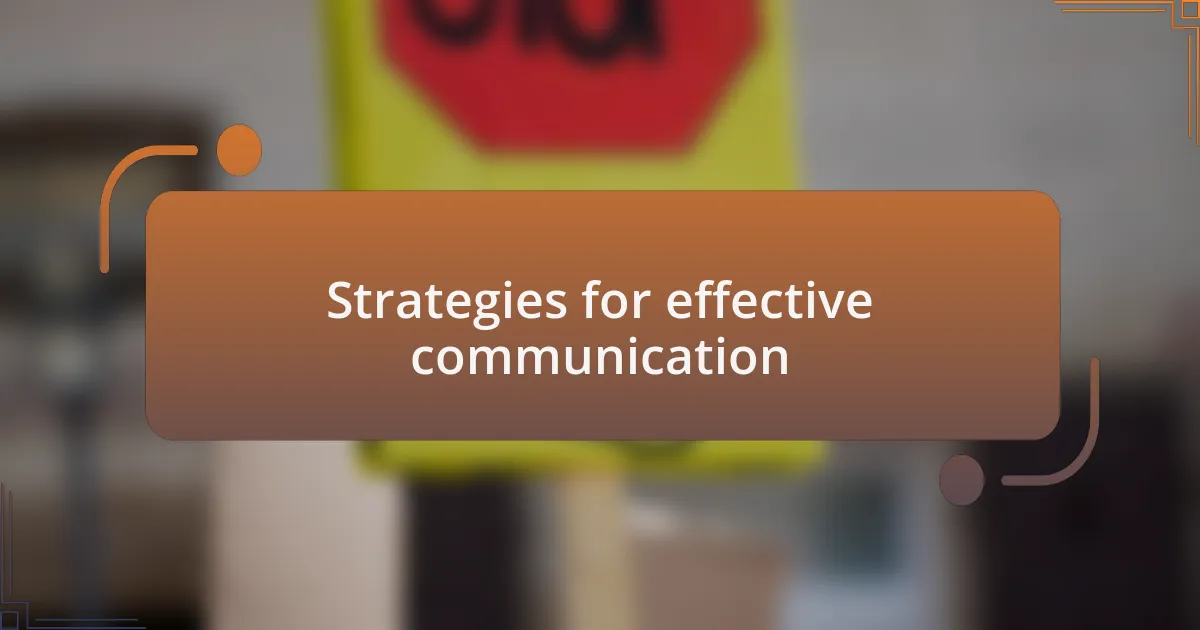
Strategies for effective communication
Effective communication in pro-life discussions often begins with active listening. I learned this valuable lesson during a community forum where I focused on understanding the concerns of others, rather than formulating my responses. As I listened deeply, I realized that many felt unheard. This experience reinforced my belief that when we truly hear one another, we can find common ground amid our differences.
Another strategy I’ve found helpful is to use “I” statements when expressing my opinions. Instead of saying, “You should believe this,” I’ve started framing my thoughts like, “I believe that…” This small shift not only softens the tone of the conversation but also invites others to share their views without feeling attacked. I recall a dialogue with a neighbor where this technique transformed a potentially confrontational exchange into a constructive conversation about our differing beliefs.
Humor can also play an unexpectedly vital role in easing tensions. During a particularly charged debate at a community gathering, I made a light-hearted comment about the absurdity of our emotional responses. Laughter broke the ice and prompted people to drop their defenses. Have you ever noticed how a shared laugh can pivot a discussion? It reminded me that engaging on a human level, with warmth and compassion, can pave the way for more effective and meaningful communication.
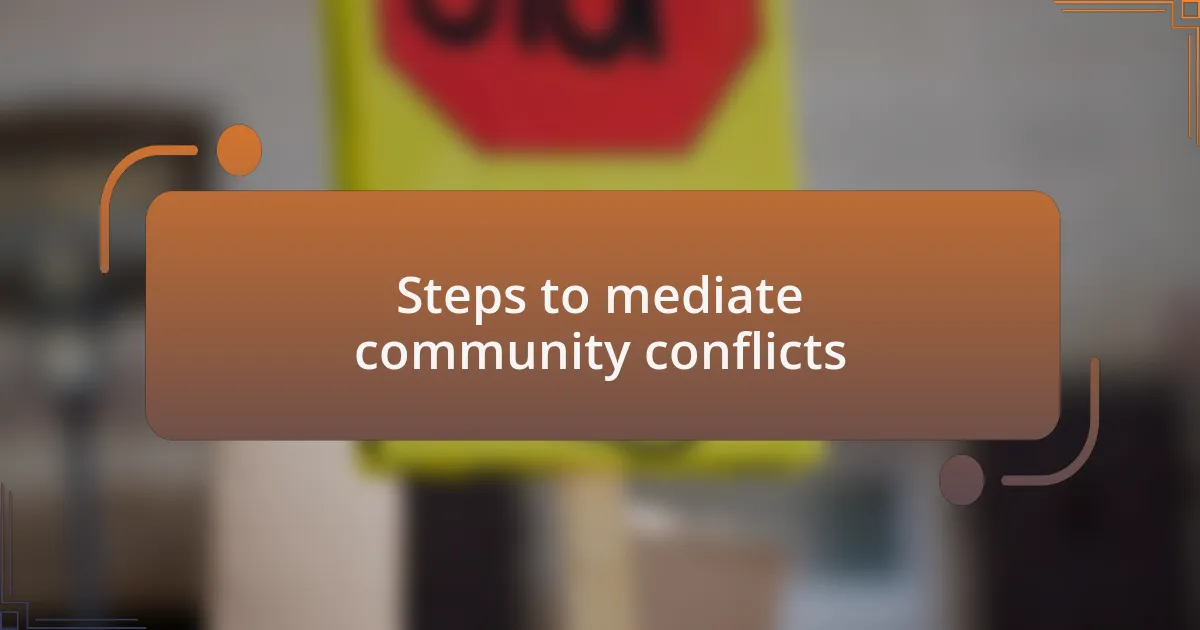
Steps to mediate community conflicts
When mediating conflicts in the community, the first step I take is to establish a safe space for dialogue. In one instance, I organized a roundtable discussion after a heated disagreement about local policies. I found that simply arranging the seating in a circle encouraged openness. People felt more equal, which helped to reduce tensions right from the start.
Once the environment is set, I emphasize the importance of setting ground rules for the conversation. One rule I always suggest is to avoid interruptions. This approach helped a group I worked with last year, where emotions ran high over a controversial topic. By creating a structure that allowed everyone to speak without being cut off, we saw a remarkable shift in tone. It really made me realize how vital it is to respect each person’s voice.
After each party shares their perspective, I encourage a collaborative brainstorming session to find mutual solutions. During a mediation about a community project, I guided participants in identifying overlapping interests. They initially seemed polarized, but as we worked together to create a list of shared goals, it struck me how powerful unity can be. Have you ever noticed that when people focus on shared aspirations rather than differences, the path forward becomes clearer? This experience illustrated the transformative power of collaboration in conflict resolution.
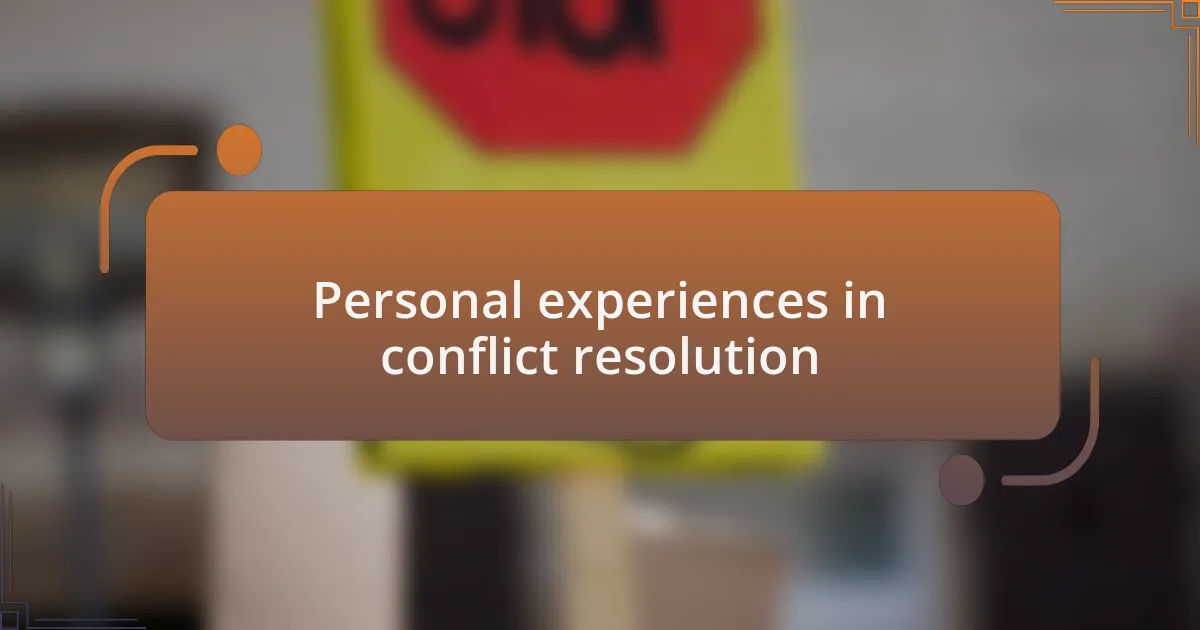
Personal experiences in conflict resolution
One memorable experience in conflict resolution happened when I intervened in a disagreement between two local groups with opposing views on a community event. Instead of taking sides, I simply asked each party to share their feelings about the situation. It was powerful to witness firsthand how vulnerable expressions could soften hardened stances, opening the door to understanding. Have you ever considered how empathy can be a game-changer in tough discussions?
In another instance, I facilitated a session where participants were frustrated by project delays. I shared a personal story about a time I felt trapped by circumstances beyond my control, and it resonated with them. This connection helped to humanize the situation; suddenly, we were not just discussing grievances; we were sharing experiences. The atmosphere shifted significantly, leading us toward constructive dialogue rather than blame. I realized in that moment that building emotional connections can be the key to unlocking solutions.
Lastly, I remember a time when we addressed misunderstandings surrounding funding for a local initiative. I used a visual aid to illustrate how funds were allocated, which transformed a complicated topic into something tangible. The room felt lighter as clarity emerged, and questions transformed into constructive input. When faced with confusion, don’t we all appreciate clear, straightforward explanations that lead to solutions? That experience reaffirmed my belief in the power of transparency as a conflict resolution tool.
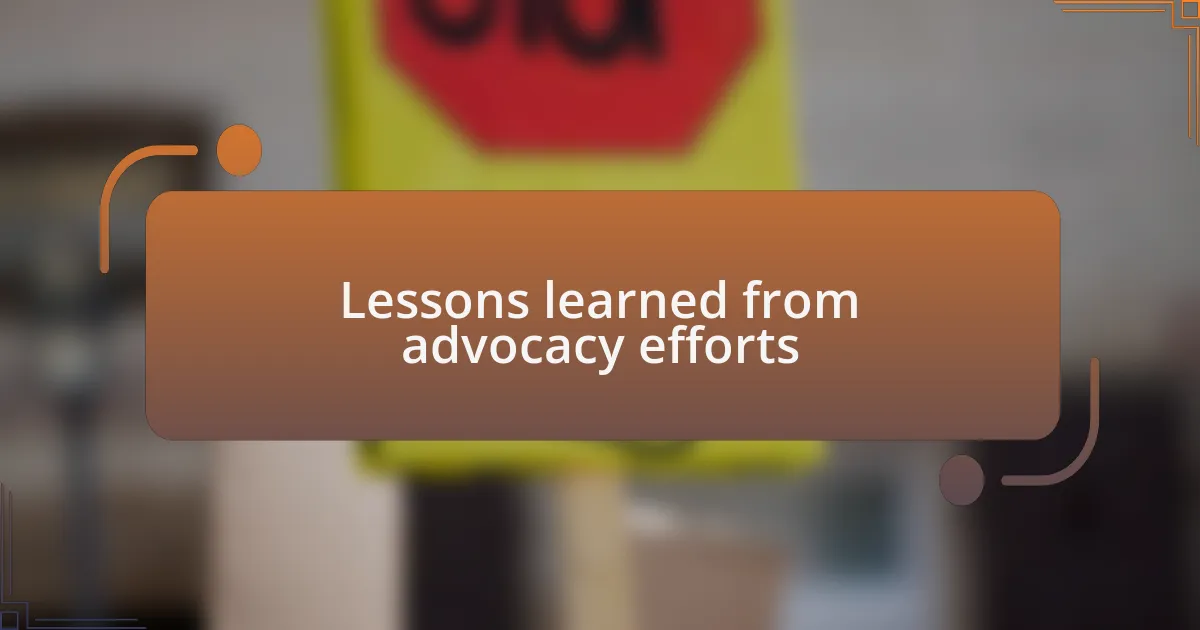
Lessons learned from advocacy efforts
One key lesson I’ve learned from my advocacy efforts is the importance of active listening. I recall a meeting where tensions were high, and emotions ran deep. Instead of jumping in with solutions, I focused on truly hearing each person’s perspective. This simple shift made it clear that we all valued being heard, paving the way for cooperation rather than contention. Isn’t it fascinating how taking a step back can create space for growth in conversations?
Another profound insight came during a workshop about community outreach. I guided a discussion on differing opinions regarding reproductive health services. Instead of presenting facts and data, I encouraged attendees to share personal stories. It struck me how deeply personal experiences could resonate, fostering a sense of unity among people with divergent viewpoints. Have you experienced how storytelling can break down walls that statistics often build?
Finally, I’ve learned the significance of patience in advocacy efforts. I once worked closely with a group for months, navigating complex emotions tied to a local policy initiative. It felt frustrating at times, yet I realized that allowing relationships to develop organically led to more meaningful engagement. Isn’t it true that sometimes, the most lasting change takes time and commitment to grow? This has been a staple in my approach ever since, reminding me that advocacy isn’t just about the immediate outcome but about nurturing lasting connections.